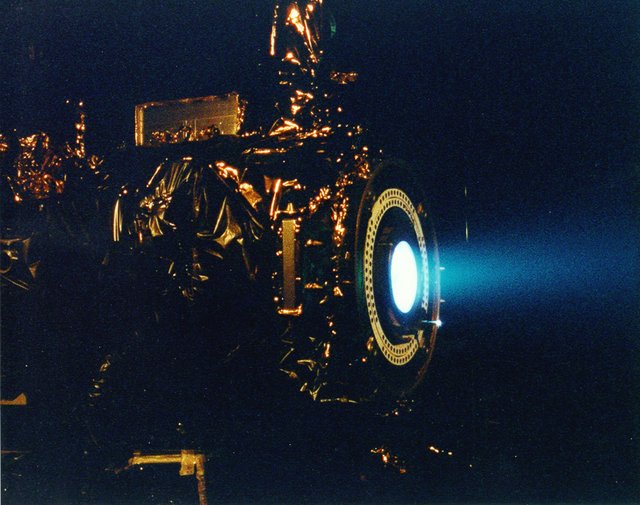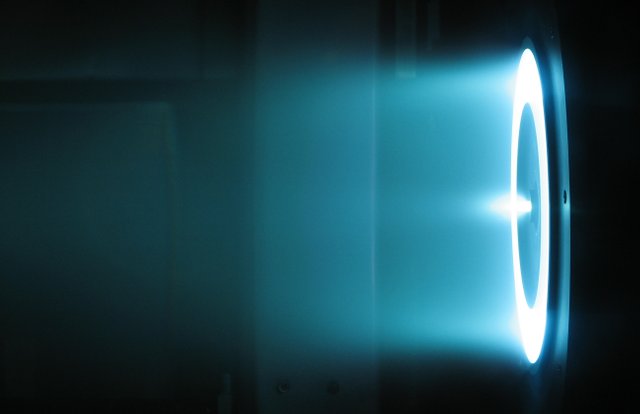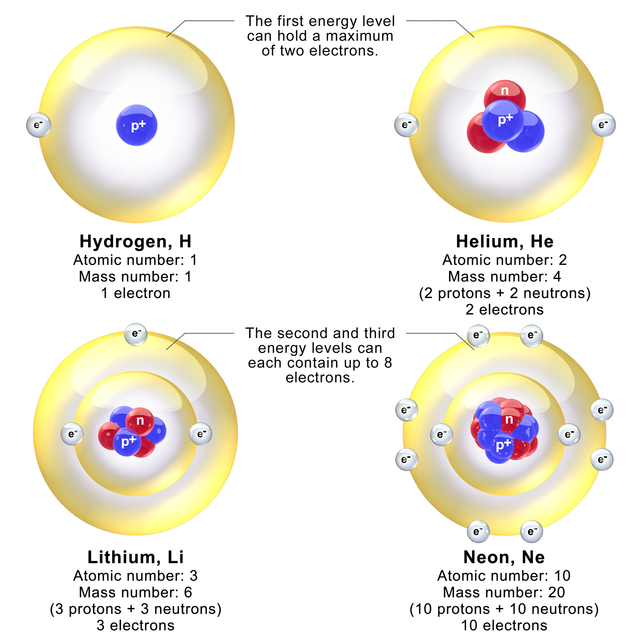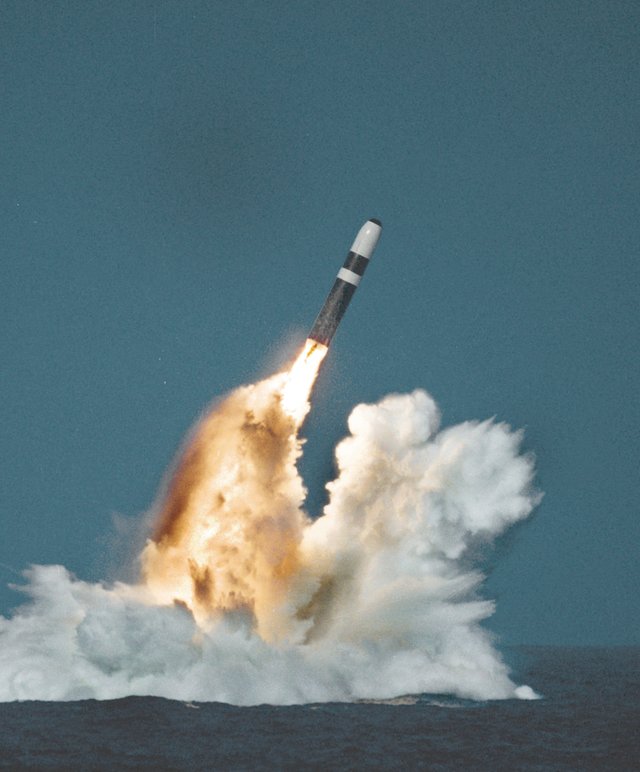Piqued #10: Ion Engines 101: The Basics

The Millenium Falcon dives into a swooping corkscrew, its ion engines flaring, as a star destroyer, with its own gigantic blue ion engine, is in hot pursuit, supported by a half dozen tie fighters, themselves accelerated by the power of ions.
When I think "ion engines", this is where my mind goes – straight to science fiction – space ships engaging their ion engines, lifting off from a terrestrial landing platform, shooting into the sky and straight out into space.
Well, I've got good new and bad news.
The bad news is that, in reality, ion engines are not quite as robust as science fiction would have us believe.
The good news is that I'm able to say "in reality" at all – because ion engines are real, baby. Right now ion engines are revolutionizing travel within our solar system, but one day an ion engine may take at least some small part of humanity out to the stars.
Today we're going to deal with how ion engines work. Next time we'll talk about current and future applications of ion engine technology.

How Does An Ion Engine Work
Broad strokes, an ion engine uses electricity - either from solar power or from an onboard nuclear generator - to ionize individual atoms of propellant, usually xenon, and shoot those ionized atoms out the back of the engine to achieve thrust.
There's a lot to unpack here, so let's get into the weeds a little.
What are ions?
Ions are atoms that have more or less electrons than they have protons.
Wait, what is an atom again?

Lets harken back to those heady days in high school chemistry class. I'll give you the high school basics. Atoms are the physical building blocks of the universe. This photo contains some simplified renditions of atoms. Here are the (very) basic rules you need to know to understand ion engines:
- Each atom has a nucleus, which consists of protons and, usually, neutrons.
- The nucleus of an atom is, usually, encircled by at least 1 electron.
- Each of the above particles, electrons, protons and neutrons, has a charge associated with it:
- neutrons = neutral charge
- protons = positive charge
- electrons = negative charge
- The number of protons in an atom cannot change, otherwise you have a different kind of atom entirely. (E.g. nuclear fusion).
- However, the number of electrons circling an atom can change, and often does, at least temporarily.
So what are Ions again?
When an atom has an equal number of electrons as it has protons, the atom is said to have a neutral charge. This is because protons have a positive charge, electrons have a negative charge, and when there are the same number of both, the two cancel each other's charges out.
An Ion is an atom that has either more electrons than protons or fewer electrons than protons.

Take a look at the photo to the right. It provides an example using a hydrogen atom, which is the simplest demonstration because hydrogen has only a single proton in its nucleus. Look at the photo:
The hydrogen atom in the center of the photo has a single electron circling its single proton. One negative charge + one positive charge equals a neutral charge. This is a neutral hydrogen atom and not an ion.
The hydrogen atom on the left has no electron. One positive charge equals a positively charged hydrogen atom, which is an ion. A positively charged ion is referred to as a cation
The hydrogen atom on the right has two electrons around its single proton. One positive charge + two negative charges = a negatively charged hydrogen atom, which is also an ion. Negatively charged ions are referred to as "anions."
This process of adding or removing ions is called "Ionization"
OK, I'll bite - what the hell is ionization?
I'm so glad you asked!
Ionization is the process by which electrons are added or removed from an atom. We, meaning human beings, use ionization as a tool all the time.
For example, take the common flourescent light bulb.
)
If you're reading this in an office, you may be under flourescent light right now. That light is made possible by ionization.
Flourescent bulbs are amazing chemical creations that I want to do a whole detailed post on in the future. But for today, we'll try to keep it concise:
The light you see coming out of a flourescent bulb is made possible by passing electricity (electrons) through cathodes. Those cathodes heat up, which releases free electrons into argon gas in the form of heat. The neutral argon takes on these free electrons and becoming negatively charged. These argon anions heat up into a glowing plasma, which in turn causes an ionizing chain reaction with mercury in the bulb. This chain reaction of ionization creates UV, which interacts with a phosphor coating, ionizing the phosphor and emitting, finally, visible light. Fluorescent light is the result of the ionization of three different materials in an ongoing chain reaction.
Cool... so, how does that move a spaceship?
An ion engine takes a noble gas, currently xenon, and ionizes it using a cathode, in much the same way as happens in a fluorescent bulb. Then, using either electrostatic or electromagnetic force, the xenon ions are sped up and and shot out the back of the ship as a the blue plasma you see to the right.

These xenon ions shooting out the back of the engine exerts a forward pressure on the ship itself - sort of like a rocket, but with a hell of lot less thrust.
A chemical rocket will expend a large amount of energy in a very short amount of time. This is why rockets are very good for, say, getting a spaceship off of the earth and into space.

Rockets use up their fuel super fast, super energetically and create a gigantic amount of thrust, very quickly. However rocket engines are not actually very efficient. (For a more detailed breakdown of space propulsion efficiencies google "specific impulse") Rockets require a lot of propellant relative to the overall amount of propulsion they provide.
Ion engines, on the other hand, are currently the most efficient propellant-based space engines that exist. However, ion engines also have a much lower thrust than chemical rockets. In fact, the meager thrust of an ion engine could never get a spaceship off the planet earth.
But, once a ship is in space, where there is no atmosphere or gravity to fight against, an ion engine really shines thanks to the conservation of momentum. Without the friction of an atmosphere or the pull of gravity to impede it, an Ion engine can eventually accelerate to great speeds while using far less propellant then a conventional rocket. It just takes a long time.
In the case of the Dawn spacecraft, which propelled itself exclusively on ion engines, the ship eventually reached 60km/s, but took many months to get that fast.

But we'll save the Dawn mission, and future applications of ion engines, for the next post. For now just remember:
TL/DR:
- Ions are negatively or positively charged atoms with more or less electrons than protons.
- Atoms become ions through the process of ionization.
- Ion engines use ionization to ionize xenon gas and then shoot those ions out the back of the ship.
- This is a very efficient process, but the thrust is very small.
- Therefore, although ion engines can achieve great speeds, they do so, very slowly, very consistently, over a very long time, especially compared to conventional chemical rocket engines.
This is, as always, an over simplification of how ion engines work. I've left out a lot of details - especially the specifics of the different methods ion engines use to accelerate the xenon ions once they are created. I encourage you to look into that in more detail if you want, but for my purposes it's only important you understand the broad strokes.
Next time: The Dawn mission and The Future Of Ion Engines.
Follow @steemstem and check out the #steemstem tag for high quality STEM related material. Also check out the Steemstem steemit chat channel.
Information Sources
https://en.wikipedia.org/wiki/Specific_impulse
https://en.wikipedia.org/wiki/Interstellar_travel
https://en.wikipedia.org/wiki/Ion_thruster
https://en.wikipedia.org/wiki/Thrust
https://en.wikipedia.org/wiki/Momentum#Conservation
https://en.wikipedia.org/wiki/Ion
https://en.wikipedia.org/wiki/Coulomb%27s_law
https://en.wikipedia.org/wiki/Lorentz_force
https://www.nasa.gov/centers/glenn/about/fs21grc.html
http://www.edisontechcenter.org/Fluorescent.html
https://en.wikipedia.org/wiki/Fluorescent_lamp
https://dawn.jpl.nasa.gov/
https://en.wikipedia.org/wiki/Dawn_(spacecraft)
https://en.wikipedia.org/wiki/Atom
https://www.britannica.com/science/Bohr-atomic-model
Photo Sources
[1]By NASA Great Images in NASA Description Public domain, via Wikimedia Commons
[2][6]By Jet Propulsion Laboratory Public domain, via Wikimedia Commons
[3]By BruceBlaus (Own work) CC BY 3.0, via Wikimedia Commons]
[4]By Jkwchui Own work CC BY-SA 3.0, via Wikimedia Commons
[5]Christian Taube CC BY-SA 2.0, via Wikimedia Commons
[7]Public Domain, US Military Photo
[8]By National Aeronautics and Space Administration Public domain, via Wikimedia Commons
Check Out My Other Posts:
The Amatuer Mycologist
Chicken Of The Woods
The Porcini
The Shaggy Mane
Piqued #7 - Solar Sails Part I
Piqued #8 – Solar Sails Part II
Also check out my awesome Marvel Coffee Table
If you liked this article, follow me for more high quality content, or resteem!
So it worked the first time. So what? A single yunk means nothing. An experiment of yunkung with only one yunk? Please - it's ridiculous. No, more tests must be done - more yunk must be uncovered...
Cool article!
I have w friends in a very exciting new StartUp that are making ION Thruster Engines for Smaller Satellites called ThrustME
You should check them out if you haven't already :)
You have some awesome friends!
Miniaturization is a huge deal -but changing the propellant to something far less expensive than xenon might be their biggest draw.
Either way, you know some folks running a mini ion thruster company! I know someone who works for a public bike exchange and that's the most interesting job
Upvoted and Resteemed by the xx_Votes_Plus curation trail! Want more earnings? Follow @dropahead in Streemian https://streemian.com/profile/curationtrail/trailing/396 and/or delegate some STEEM POWER to @dropahead! Keep up the good work!
Really nice work @dber, very nice explanation of ion engines, and their uses (moving things in low friction environments) and draw backs (lack of thrust, not good for getting off the planet).
Thanks! My persistent goal is clarity and to avoid leaving errors for lemouth to find :)
That's a lofty goal. Lemouth is like a blood hound for errors.
I'm counting on it :)
Nice
Thanks!
Nicely explained, didn't know ion engines were more energy efficient~
They have a higher specific impulse - meaning they really sip propellant - i
Great post! You made me recall that photon(like using laser) can also work similarly theoretically, but it is just even far less efficient haha
Yeah radiation pressure is the real deal - check out the prior posts on solar sails.
Congratulations! This post has been upvoted from the communal account, @minnowsupport, by DBER from the Minnow Support Project. It's a witness project run by aggroed, ausbitbank, teamsteem, theprophet0, and someguy123. The goal is to help Steemit grow by supporting Minnows and creating a social network. Please find us in the Peace, Abundance, and Liberty Network (PALnet) Discord Channel. It's a completely public and open space to all members of the Steemit community who voluntarily choose to be there.
If you like what we're doing please upvote this comment so we can continue to build the community account that's supporting all members.
@dber got you a $3.86 @minnowbooster upgoat, nice! (Image: pixabay.com)
Want a boost? Click here to read more!
Excellent post brother! You did a very good job explaining the science behind it which will prepare all of us for the next installment.
Peace,
The Last Sage
Congratulations @dber! You have completed some achievement on Steemit and have been rewarded with new badge(s) :
Click on any badge to view your own Board of Honor on SteemitBoard.
For more information about SteemitBoard, click here
If you no longer want to receive notifications, reply to this comment with the word
STOP